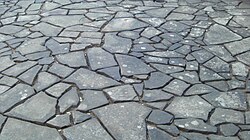Engineering:Crazy paving
From HandWiki
Short description: Means of hard-surfacing used outdoors, most often in gardens
Crazy paving is a means of hard-surfacing used outdoors, most frequently in gardens. Paving stones of irregular size and shape are laid in a haphazard manner sometimes with mortar filling the gaps between.
The method originated in ancient Rome.[1] The design was half-way between mosaic and sectile and primarily used chippings of white and colored limestone.[2] It sets up the paving stones without geometric grid so that they are used as they naturally break as opposed to being cut in geometric shapes.[3]
Crazy paving became popular during the 1970s and the use of just one type of stone is among the modern updates.[4] Today, the hard-surfacing approach is also used as a means to recycle paving materials.[5]
See also
- Crazy quilting
References
- ↑ White, Hazel; Plut, Matthew (1998). Paths and Walkways: Simple Projects, Contemporary Designs. Chronicle Books. pp. 80. ISBN 0-8118-1429-7. https://archive.org/details/pathswalkwayssim0000whit. Retrieved 2008-07-18. "Crazy paving."
- ↑ Ling, Roger (1991). Roman Painting. Cambridge, UK: Cambridge University Press. pp. 19. ISBN 978-0-521-31595-1. https://archive.org/details/romanpainting0000ling. Retrieved January 22, 2023.
- ↑ Relating Architecture to Landscape. London: Taylor & Francis. 2005. pp. 83. doi:10.4324/9780203352601. ISBN 0-203-35260-2.
- ↑ Young, Chris (2017). Encyclopedia of Landscape Design: Planning, Building, and Planting Your Perfect Outdoor Space. London: DK Publishing. pp. 352–353. ISBN 978-1-4654-7078-2.
- ↑ Lawrence, Mike (2011). Masonry and Plastering. Marlborough, UK: Crowood. pp. 75. ISBN 978-1-84797-351-1. https://archive.org/details/masonryplasterin0000lawr_d3s1. Retrieved 2023-01-22.
 |


